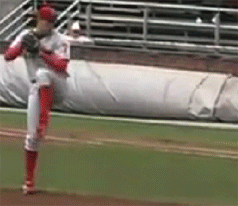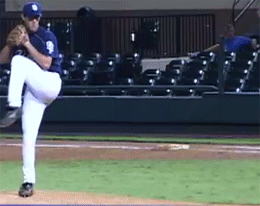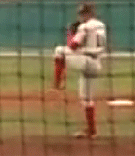Alex Eisenberg, the brains behind baseball-intellect.com has provided me with tons of good Phillies related bits in the past, and he reached out to me to provide this detailed scouting report, along with mechanical analysis, of Phillies prospect Brody Colvin. Eisenberg ranked Colvin 4th in the Phillies system and assigned him a B grade. His full thoughts will be outlined in the post below. In addition, he’s offering a special deals for access to his members only exclusive content by clicking on this link. He provides tons of excellent scouting reports, video analysis, and other goodies during the season, including coverage leading up to the draft. So check that out if you’re interested. Now, the full report from Alex on Brody Colvin, below the fold.
Alex’s scouting report is below
———————————————————————————————————-
Body Type – Muscular with a great pitcher’s frame.
Stuff
Fastball – Sits in the 93 – 95 mph range, touching higher. The pitch possesses excellent late life.
Curveball – Potential above average pitch, but needs to improve the consistency of the pitch. Its bite is sometimes softer than you’d like to see, and he’s prone to hanging it. But it’s effective when it’s on, especially against right handers because it comes in at an where the pitch looks like it’s coming at them once released from Colvin’s hand. He has an ability to backdoor the pitch to lefties. Has to make sure he stays on top of the pitch so it gets the depth it needs.
Change-Up – Another potential above average pitch with solid sink. Like the curveball, it needs more consistency.
Scouting Report
Colvin was a guy I aggressively ranked last year, and despite an extremely rough April, he seems to have lived up to the high praise. To say Colvin’s April was rough is actually an understatement. He ended the month with an 11.15 ERA. However, Colvin made what was an impressive turnaround, which you could say speaks for his mental make-up. Such a poor performance can sometimes snowball on a player, so the fact that he bounced back is a great sign. Once May hit, his peripherals jumped around a bit, but fell into a fairly defined range. His K% ranged between 18.8% to 24.4%, and his W% ranged between 3.3% to 9%. This is compared to a K% and W% of 11.1% in April. In later months, not only was he throwing more strikes and missing more bats, but he was inducing more ground balls as well. The fact that Colvin was throwing strikes at as solid a rate as he was last year was something of a surprise. I and many others felt — at least initially in his pro career — he would struggle to throw strikes, and that he’d be able to get by with good stuff.
Mechanics
Part of my reasoning for thinking that way came down to his mechanics, especially regarding what he did on his front side. Here is what I said in his write-up last year, in comparing his mechanics to those of Justin Verlander:
And then notice the front side mechanics. That’s the big difference here…Verlander maintains a firm glove out in front of the chest and brings his chest to the glove. Colvin does firm up, but the glove is positioned to his side down by his knee and as a result, Colvin’s front shoulder is at risk for flying open. This is where I’m reminded a bit of Aumont. It’s also a mechanical attribute that hurts his command.
Well, here is how his 2010 mechanics (left) compare to his high school mechanics (right). See if you can detect any changes:
*Credit to PhilliesProspects and to the MLB Scouting Bureau
If you haven’t picked it up, watch the action of the glove arm as the front shoulder starts opening. The glove is firmed up, out in front of his chest, and he lets the chest meet the glove, rather than pulling it down by his side. Look at his adjustments from behind home plate:
*Credit to PhilliesProspects and to the MLB Scouting Bureau
I pause the graphics at the time of release. Now which version looks more closed to you? The benefits of being able to consistently keep his front shoulder closed is better command, more deception (by staying closed, he’s essentially hiding the ball better, making his release point more difficult to pick up), and a lower risk of injury.
The front side mechanics are not the only adjustments he’s made. He’s also smoothed out his arm action, and adjusted his leg kick and stride into foot plant, which is not as linear as it was before, and now is more rotational instead.
Because his stride is a little more rotational, and also because his back is turned slightly more away from the hitters, he lands closed, meaning he throws across his body. Cross body motions have their pros and cons, but one thing I do like from it is that the angle he releases his ball makes things very difficult for right handed hitters.
Colvin’s stuff is better than his stat line lets on. Based on his upside, his improvement over the course of the 2010 season, and with a year of pro experience now under his belt, Colvin is one of the better candidates to breakout next season.
Best Case Outcome – No. 2 starter
More Likely Outcome – No. 3 starter
Alex Eisenberg runs the site Baseball-Intellect, where he breaks down prospects using video analysis. He offers a Premium Membership for readers to join and has worked for the Hardball Times, Baseball Digest Daily, and has had work published for the Maple Street Press.
————————————————————————————————–
Thanks again to Alex for providing his insight and in-depth breakdown of one of our best prospects.




Could someone give me a stat line or something of what they mean when they say #2 pitcher? Because if I look at actualy #2 pitchers, it runs the gamut from Cliff Lee to Chad Billingsley to whomever the Royals are trotting out this year (Bannister? Hochever? I have no idea.)
That’s a pretty big difference in #2 starters.
LikeLike
Hunter, every team has a starter that is second best in the rotation. Not every team has an actual No. 2 starter…some teams have multiple guys you’d consider No. 2 starters.
I don’t have any strictly defined way of looking at a No. 2 starter…just going by the most basic stat to judge a pitcher’s success (ERA) and figuring you adjust for competition, ball park, etc, I’d argue a No. 2 starter is somewhere between a 3.30 and 4.10 ERA…actually make that FIP or xFIP which would probably be the better judge of whether a pitcher is actually a true No. 2 starter…gives you a better sense of a pitcher’s ability.
Anyway, that range can slide depending on the quality of pitching league wide in a given year.
LikeLike
A number 1 or 2 pitcher isn’t referring to where they pitch in a given teams lineup. In this instance a number 1 pitcher would be one of the top 15 pitchers in baseball(depending on who you talk to). A number 2 pitcher is 16-30, a number 3 is 31-50/60 and so on and so forth. That’s how the Phillies have 2 1’s and 2 2’s.
LikeLike
I won’t speak for Alex, but I think a “#1 starter” is basically a bona-fide legit ace. A Roy Halladay, Pedro Martinez, Ubaldo Jimenez, Felix Hernandez type. They are rare. Every team has a guy who starts on opening day and is their “ace”, but the talent level there varies from team to team. Cliff Lee now is a #1 caliber starter, but wasn’t when he came up, because his command wasn’t as good. I think the range of outcomes for a #2 the way most scouts think about it anything from being close to the elite upper level guys and being a solid, above average league starter. Jeremy Guthrie is the Orioles opening day starter, and their #1, but on a good team, is probably only a #4 starter.
Those types of distinctions are really just guesstimates anyway.
LikeLike
Thank you for your reply…so a good #2 starter would be like a 3.5-4.5 WAR guy, whereas the true aces are 5.0+ WAR guys?
LikeLike
That sounds fair. 4.5-5+ WAR= #1 starter. #2 starter is probably 3-3.5 or better. #3 starter at 2.0 WAR, #4 starter at 1.0+ WAR.
So for example, a starting rotation might be:
#1: Roy Halladay (6.9 WAR)
#2. Mark Buehrle (3.5)
#3. Johnny Cueto (2.1)
#4. Jeff Niemann (1.1)
#5. Nick Blackburn (0.1)
LikeLike
This is pretty perfect. Publish this. Profit.
LikeLike
My guess is that a contending team generally gets more than 2 WAR out of the #3 starter spot given that is a league average total. But, it certainly varies. Derek Lowe to me feels like a guy who is an “elite” #3 starter, if that makes any sense.
LikeLike
Yup, that about sums it up…and as an Oriole fan that sorta depresses me. Though I actually think Brian Matusz is our No. 1 guy and expect to at least pitch to the level of a true No. 2 this year.
LikeLike
I always understood projections like “#2 starter” to refer to the player’s place on a good/playoff caliber team. Is that how most scouts think of it?
LikeLike
I still really like Colvin. He seems destined to be a quality starter and I hope to be able to compare him to Drabek in two years.
LikeLike
I don’t think scouts label prospects #1 or #2 pitchers based on arbitrary projection of where they think the pitcher could rank (1-15 vs 16-30). I think scouts base their judgment on how many plus pitches and the level of command they think the pitcher projects to have.
Baseball America makes it very simple to understand:
No. 1: Two plus pitches, one average pitch, plus-plus command, plus make-up.
No. 2: Two plus pitches, one average pitch, average command, avg make-up.
No. 3: One plus pitch, Two average pitches, average command, avg make-up
Closer: One dominant pitch, second plus pitch, plus command, ++ make-up
From the BA discriptions, and how the scout describes Colvin’s stuff, it seems Colvin has a #2 ceiling because he doesn’t project to have plus command. #2 is optimistic, but fair, because it implies that his breaking ball will be plus.
LikeLike
Based on the BA descriptions, I have Colvin as most likely a #3 pitcher, with a decent chance to be a #2.
I have Jared Cosart as a Closer, because of a potential dominant Fastball, plus command, and potential plus curve. I think he has a ceiling of #1 pitcher, but that is very optimistic.
May’s ceiling is #3, but I think he will be a back-end starter or Reliever.
JC Ramirez’ ceiling is #3, but I think he will be a set-up guy because he can’t command his breaking ball.
Worley’s ceiling is 4-5 starter, because he has no plus pitches.
DeFratus’ ceiling is set-up guy, due to one plus pitch.
LikeLike
Cosart…to me, health is the only thing that will keep him from the starting rotation. He has all the ingredients to be a No. 1 starter if he stays healthy.
LikeLike
Actually, this is probably a better explanation of defining what type of starter a pitcher is than my comment above. I defined the type of starter a pitcher is from their production.
LikeLike
Thanks for the reply. Good insight on Colvin
LikeLike
Amazing how sharp the relievers Stutes and Aumont looked with their control and command in ST games compared to how the starters Cosart and especially Colvin looked.
LikeLike
I still am not entirely sure what to make of Colvin and his ceiling, but I believe he has the talent level to be above average and possibly more. At this point projecting him as a #2-3 starter seems reasonable, but he could potentially be a #1 depending on how well he continues to develop.
Cosart is thought to have at least a slightly higher ceiling, but less likelyhood of reaching it due to injury concerns, but then again Cole Hamels had considerable injury concerns as he was coming up through the minors, but he’s been fairly healthy since making the Majors in ’06, with only a few minor injuries which kept him out a limited amount of time.
Speaking of Left-Handed starters, I wonder how high Jesse Biddle’s ceiling truly is. Due to his young age, it’s very hard to project what he could end up being. Based on what I know of him from scouting reports, his worth ethic and so on, I think he could be a great pitcher…possibly a guy who could compare favorably to Cole Hamels, but a lot will depend on how the next few years go.
LikeLike
If that happens, I will jump for joy…though I’d swap some pitching (lord knows we have a ton of it) for some top flight minor league prospects, especially in skill slots in the infield… (non-1B)
LikeLike
Wow!!!!! what are they thinking! The office or who ever picks who goes and who stays, truly suck at their job!! The so called bonus babies some are a joke and the scout that signed them should be fired!! then you have those kids that played D-1 college and have proved themselves, but there is one thing some have no money invested in them so the so called bonus babies get moved up because they have that advantage!!! Whats this world coming too a sucking deal!!!!
LikeLike
Well if they are that good, they should have no problem signing on somewhere else, right?
But I do agree the org. does give every chance to guys who got big bonuses and were projected to have a high ceiling…but I don’t think the Phillies org. is unique in that.
LikeLike
I’m guessing one of your favorite organizational fillers just got released?
LikeLike
Alex,
Just wanted to thank you for the write-up, but even more so you taking the time to check in and answer the question that was asked (which I thought was a great question). Love this site, and I’ll be checking out yours as well.
Thanks again.
LikeLike
This was in David Murphy’s column today: Expectations: Hernandez is a second baseman, but there are some who believe his future position is shortstop. Since the Phillies signed him out of Venezuela in 2007, Hernandez has shown a good approach at the plate and good speed and instincts on the base paths. Although 21-year-old Freddy Galvis has drawn raves for his fielding ability at short, he has yet to develop into a dependable offensive player: In four seasons, including 2010 at Double A Reading, Galvis has a .233 average and .575 OPS. Hernandez should see time at low-A Lakewood.
I wonder who told him that Hernandez can play short, when I saw him I didn’t think he had a strong arm, but maybe at second he didn’t feel he had to air it out.
LikeLike
There’s no way his arm is strong enough for SS.
LikeLike
So what does Murphy say here? “there are some who believe his future position is ShortStop” Maybe the some who believe it are ones he read on this website. These guys have to write something most every day and it wouldn’t be a stretch to see them fan some flames of mild controversy for a sentence or two to improve an article, with a flimsy factual basis as its underpinnings.
LikeLike
It was in BA’s writeup. No doubt one of the scouts they talked to voiced an opinion. My suspicion is that the opinion is a year or two old. Hernandez is a 2B going forward.
LikeLike
Yeah, it would seem that way, and looked up who played what at various stages. Cesar H. played 43 games at SS in VSL in ‘o7 and 12 at 2B. The following season Edgar Duran took over (’08) and played 51 games at SS (Hernandez 51 at 2B), and it would seem the range was better as in 7 more games Duran had 41 more assists and better F%.931 to .920 (and a better R/F (though what that means unknown to me , and as they fed each other at 2B and SS. Then in ’09 in GCL C. Hernandez had 38 games at 2B while SS was manned by Duran (31 games ) and Jonathon Villar (28 games).
Then last season in WPT it was C. Hernadez 65 games at 2B and Duran 71 games at SS. They are somewhat comparable there allowing for Hernandez played most all the 2B and Duran most all the SS, and the range factors are influenced by feeding each other. 2 things may be that comparing the full season at SS between Cesar and Duran, Duran seemed to have more range and the organization has preferred Duran and others as a SS.
LikeLike
Rosters have been posted. Teams are made!
LikeLike
and????
LikeLike